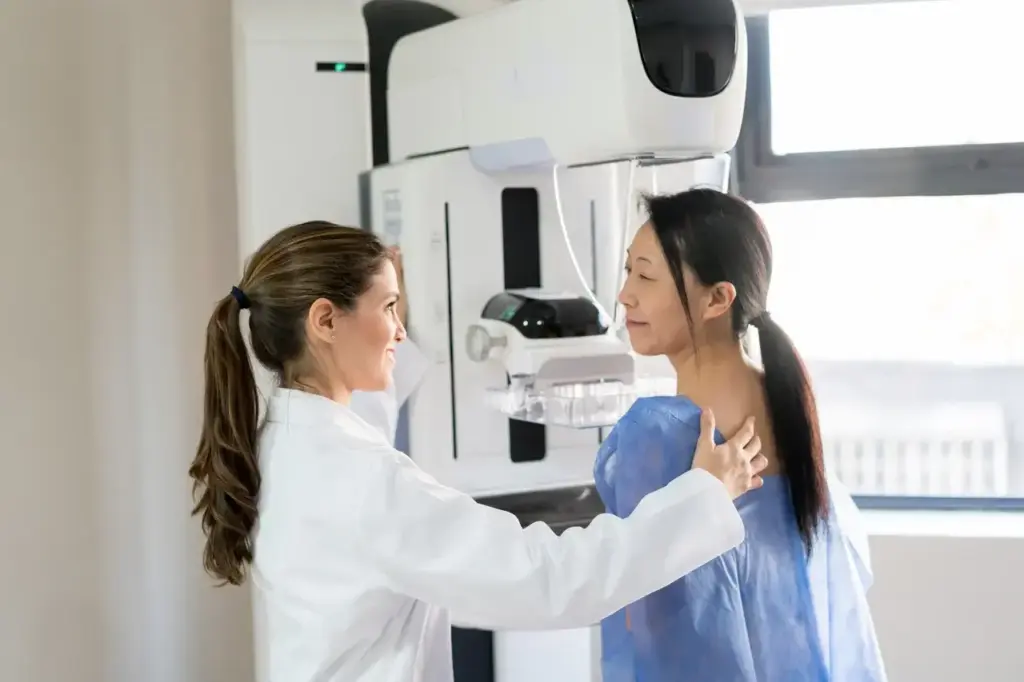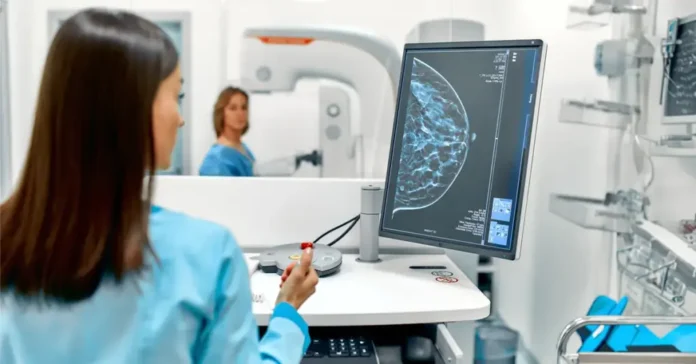Lobular carcinoma in situ (LCIS) is a benign breast condition characterized by abnormal cell presence within the milk-producing glands (lobules) of the breast. Although not cancerous, LCIS serves as a significant risk factor for the future development of invasive breast cancer.
Key Highlights about Lobular Carcinoma in Situ (LCIS):
- LCIS, a rare condition, typically remains asymptomatic.
- Detection often occurs through routine mammograms or breast biopsies.
- Women with lobular carcinoma in situ (LCIS) face an approximately 10-fold increased risk of invasive breast cancer.
- Immediate treatment for lobular carcinoma in situ (LCIS) is unnecessary, but regular breast cancer screening is strongly advised.
- LCIS is an uncommon condition with abnormal cells confined to the milk-producing glands of the breast.
- LCIS is not breast cancer but increases the risk of developing breast cancer in the future.
- LCIS is more common in women between the ages of 40 and 60.
- LCIS is not considered pre-cancerous because the abnormal cells rarely spread.
What are lobules and lobular carcinoma in situ (LCIS)?
Lobules, responsible for milk production, house abnormal cells in lobular carcinoma in situ (LCIS). These irregularities are confined to the lobules without spreading to adjacent tissues.
LCIS and the Risk of Invasive Breast Cancer:
Despite its non-cancerous nature, LCIS heightens the risk of future invasive breast cancer. The exact mechanism behind this increased risk is not fully clear but is believed to involve genetic changes within the abnormal cells.
Management of Lobular Carcinoma in Situ (LCIS):
Presently, there is no standardized treatment for lobular carcinoma in situ (LCIS). However, vigilant breast cancer screening remains imperative for early detection. In certain cases, preventive medications may be recommended to further diminish the risk of developing invasive breast cancer.
Men and Lobular Carcinoma in Situ (LCIS):
While predominantly affecting females, LCIS can exceptionally occur in men. Management parallels that in women, involving regular breast screening mammograms and, in certain instances, preventive medication.
LCIS, while non-cancerous, elevates the risk of future invasive breast cancer in women. Consistent breast cancer screening plays a crucial role in early detection and timely intervention if any potential invasive breast cancer development is identified.
What is Lobular Carcinoma in Situ (LCIS)?
Lobular carcinoma in situ (LCIS) is an uncommon condition characterized by the presence of abnormal cells within the lobules, the milk-producing glands of the breast. These abnormal cells remain confined to the lobules and have not invaded or spread to surrounding breast tissue. As a result, LCIS is not considered breast cancer. However, it does indicate an increased risk of developing breast cancer in the future.
How common is lobular carcinoma in situ?
LCIS is a relatively rare condition, affecting approximately 4 to 11 women per 100,000. It is even less common in men, with only about 1 in 100,000 men developing breast cancer, and LCIS accounting for 2% of those cases.
Who is affected by lobular carcinoma in situ?
LCIS is most frequently diagnosed in women between the ages of 40 and 60.
Is Lobular Carcinoma in Situ (LCIS) Considered Pre-Cancerous?
LCIS is not considered pre-cancerous because the abnormal cells in the lobules rarely spread to surrounding breast tissue. However, lobular carcinoma in situ (LCIS) does increase the risk of developing breast cancer in the future.
About Lobular Carcinoma In Situ (LCIS)
Lobular carcinoma in situ (LCIS) is a noncancerous condition in which abnormal cells develop within the lining of the milk glands (lobules) in the breast. These abnormal cells can’t spread beyond the lobules and do not pose an immediate threat. However, women with LCIS have an increased risk of developing invasive breast cancer in the future.
Unlike invasive breast cancer, LCIS typically does not cause any noticeable signs or symptoms. It is often discovered incidentally during a biopsy performed for another reason, such as a suspicious lump or an abnormal mammogram.
When to See a Doctor
If you notice any changes in your breasts, such as a lump, a puckered or dimpled area, a thickened region under the skin, or nipple discharge, schedule an appointment with your doctor promptly.
Regular breast cancer screening is recommended for most women beginning in their 40s. Discuss with your doctor to determine the appropriate screening schedule and methods for you.
Causes of Lobular Carcinoma in Situ (LCIS)
The exact cause of lobular carcinoma in situ (LCIS) remains unclear. It is believed to arise from genetic mutations that occur within the cells of the breast lobules. These mutations cause the cells to appear abnormal, but they do not enable them to spread beyond the lobules or invade surrounding tissues.
Risk of Breast Cancer
Women with LCIS have an approximately 20% lifetime risk of developing invasive breast cancer, compared to the general population’s risk of 12%. Your individual risk of breast cancer depends on various factors, including your family history of breast cancer, personal health, and lifestyle. It is crucial to discuss your risk factors with your doctor to understand your personalized risk assessment.
Breast Anatomy
Each breast contains 15 to 20 lobes of glandular tissue, arranged like the petals of a daisy. These lobes are further divided into smaller lobules that produce milk for breastfeeding. Tiny tubes (ducts) carry the milk to a reservoir just beneath the nipple.
Understanding LCIS and its potential implications can help you make informed decisions about your breast health. Regular checkups, self-examinations, and discussions with your healthcare provider are essential for the early detection and effective management of any breast-related concerns.
Lobular and Ductal Breast Cancer: What is the Difference?
Ductal Carcinoma in Situ (DCIS) and Lobular Carcinoma in Situ (LCIS): Understanding the Differences
If you’ve recently received the results of a breast biopsy indicating abnormal findings, it may involve either ductal carcinoma in situ (DCIS) or lobular carcinoma in situ (LCIS), both categorized as very early-stage breast cancers.
Both DCIS and LCIS share the term “in situ,” signifying that abnormal cell growth is confined to its origin and hasn’t spread to surrounding tissue.
What is lobular breast cancer?

Lobular breast cancer (ILC), the second most prevalent subtype within the complex landscape of breast cancer, constitutes about 10% of all cases. Unlike invasive ductal carcinoma (IDC), ILC showcases a unique growth pattern, often presenting as subtle thickening or fullness rather than forming firm lumps. This, coupled with its tendency to grow in single-file lines through the breast, renders ILC more challenging to detect through self-examination.
Despite its elusive nature, ILC is not impervious to detection, and early identification remains pivotal for successful treatment. Early-stage ILC can be effectively managed through a combination of surgery, radiation therapy, and chemotherapy. Notably, for patients with estrogen receptor-positive (ER-positive) tumors, endocrine therapy targeting estrogen reduction emerges as a highly effective treatment option.
The International Breast Cancer Study Group (IBCSG) conducted a study involving over 13,000 patients with ILC and IDC. Findings revealed that, at the same time as ILC is associated with older age, larger tumors, and a better chance of mastectomy, it, to begin with, appears to have a greater favorable prognosis as compared to IDC.
However, this advantage diminishes through the years, with ILC patients showing decreased disorder-free and universal survival prices at later levels.
Researchers additionally cited that, while local recurrence rates are comparable for ILC and IDC, the styles of recurrence fluctuate. ILC patients are more susceptible to distant recurrences, regularly regarding the peritoneum, ovaries, and gastrointestinal tract. In assessment, IDC sufferers are much more likely to revel in local recurrences and lung metastases.
These findings underscore the importance of information on the particular traits of ILC and tailored treatment strategies. By spotting the wonderful increase patterns, recurrence styles, and remedy responses associated with ILC, we will enhance patient outcomes and ultimately cause better long-term survival costs.
Navigating the Nuances of Lobular and Ductal Breast Cancer
Breast cancer, a complex disease with various subtypes, demands a nuanced approach for effective diagnosis and treatment. Two prevalent types, lobular and ductal breast cancer, exhibit unique characteristics that influence their management. Grasping these distinctions is crucial for both patients and healthcare professionals.
Ductal Breast Cancer: The Predominant Type
Ductal breast cancer, or invasive ductal carcinoma (IDC), constitutes around 80% of breast cancer cases. Originating in the milk ducts, it often begins as ductal carcinoma in situ (DCIS), a non-invasive condition confined to the ducts. Ductal cancer’s invasive nature allows it to spread beyond the ducts, forming detectable masses or lumps. Subtypes like invasive ductal carcinoma of no special type (IDC-NST) exist, each demanding tailored treatment involving surgery, chemotherapy, radiation therapy, and targeted therapies.
Lobular Breast Cancer: A Unique and Less Common Variant
Lobular breast cancer, or invasive lobular carcinoma (ILC), is distinctive but less prevalent, constituting 10–15% of breast cancer cases. Unlike ductal cancer, it originates in the milk-producing lobules, often challenging detection due to its diffuse growth pattern. Infiltrating surrounding tissue in a single-file pattern, lobular cancer can be harder to diagnose and occasionally occurs bilaterally. Treatment mirrors that of ductal cancer, considering surgery, radiation, chemotherapy, and targeted therapies.
Ductal Cancer vs. Lobular Cancer
- Site of origin: Ductal cancer starts in milk ducts, while lobular cancer originates in milk-producing lobules.
- Growth Patterns: Ductal cancer forms solid masses, facilitating detection, whereas lobular cancer grows diffusely and can be harder to identify.
- Invasive Patterns: Ductal cancer spreads by infiltrating surrounding tissues, while lobular cancer invades in a single-file pattern.
- Incidence: Ductal cancer is more prevalent, constituting 80% of cases, while lobular cancer is less common, accounting for 10-15%.
Navigating the Path to Effective Treatment
While these cancers share similarities, differences in origin, growth, and invasiveness have vital diagnostic and treatment implications. Collaboration with healthcare providers is essential for tailoring treatment plans to individual needs. Early detection through regular screenings remains a crucial defence against both lobular and ductal breast cancer, emphasizing the significance of awareness and proactive healthcare.
DCIS vs. LCIS: Key Differences
- Location: DCIS affects the milk ducts of the breast, while lobular cancer in situ (LCIS) affects the milk-producing lobules.
- Risk of Progression: DCIS has a higher risk of progressing to invasive breast cancer compared to LCIS.
- Treatment: Treatment options for ductal carcinoma in situ (DCIS) and lobular cancer in situ (LCIS) vary based on factors like the extent and grade of abnormal cells.
The phrases “ductal carcinoma in situ” (DCIS) and “lobular carcinoma in situ” (LCIS) can evoke issues among girls, as each involves unusual mobile growth inside the breast. However, it is vital to understand the nuances between these conditions and draw attention to their implications for breast cancer risk.
Ductal Carcinoma in Situ (DCIS)
DCIS represents early-level breast cancer, often known as degree zero. It originates from strange cellular growth in the milk ducts, the tubular systems responsible for sending milk to the nipple. Unlike invasive breast cancers, ductal carcinoma in situ (DCIS) stays constrained to the ducts, not breaching the duct walls to unfold to surrounding breast tissue.
Despite their non-invasive nature, untreated ductal carcinoma in situ (DCIS) cells can transform into invasive breast cancer. The risk of development varies based on the sort and grade of DCIS; however, standard, approximately 15-20% of untreated DCIS instances might also change into invasive cancer over the years. Understanding these nuances is essential for informed selection-making and proactive management of breast health.
Lobular Carcinoma in Situ (LCIS)
LCIS, on the other hand, is not technically considered a type of cancer. It involves abnormal cell growth within the lobules, the milk-producing glands of the breast. Unlike DCIS, LCIS cells don’t have the potential to directly transform into invasive breast cancer.
Nevertheless, LCIS does heighten a woman’s overall risk of developing invasive breast cancer in either breast, even extending to the one without LCIS, with the increased risk estimated to be approximately 1-2 times higher than average.
Key Differences between DCIS and Lobular Carcinoma in Situ (LCIS)
The primary distinctions between DCIS and LCIS revolve around their definition, potential for progression, and impact on breast cancer risk:
Definition:
- DCIS is classified as an early-stage breast cancer.
- LCIS, on the other hand, is not considered a type of cancer.
Potential for Progression:
- DCIS cells possess the capability to transform into invasive breast cancer.
- LCIS cells, in contrast, cannot directly evolve into invasive cancer.
Impact on Breast Cancer Risk:
- DCIS heightens the risk of developing invasive breast cancer in the same breast.
- LCIS elevates the overall risk of developing invasive breast cancer in either breast.
Treatment Considerations
Approaches to treatment for both DCIS and LCIS typically adopt a multidisciplinary perspective, factoring in considerations like the patient’s age, overall health, and personal preferences. For DCIS, treatment options may encompass surgery, radiation therapy, or hormonal therapy. Meanwhile, regular breast cancer screening is often recommended for LCIS, aiding in the early detection of any potential changes.
A nuanced understanding of the contrast between DCIS and LCIS is pivotal for women to make informed decisions regarding their breast health. While both involve abnormal cell growth, DCIS is characterized as an early-stage breast cancer with the potential for progression. In contrast, LCIS is not classified as a type of cancer but amplifies the overall risk of developing invasive breast cancer.
Regular breast cancer screening, coupled with open communication with healthcare providers, stands as essential for the early detection and proactive management of potential breast health concerns.
Invasive Lobular Carcinoma (ILC): A Detailed Examination
Invasive lobular carcinoma (ILC) stands as the second most common type of breast cancer, constituting approximately 5–15% of all cases. It differs from the more prevalent invasive ductal carcinoma (IDC) in clinicopathological characteristics and treatment response.
Key Findings from a Retrospective Study
A comprehensive study comparing ILC and IDC patients unveiled significant differences:
- Patient Characteristics: ILC patients were typically older and more likely to have lower-grade tumors.
- Tumor Stage and Size: ILC patients were more prone to higher-stage disease and larger tumors.
- Hormone Receptor Status: ILC patients were more likely to have hormone-receptor-positive tumors.
- Treatment: ILC patients were more inclined towards mastectomy and less likely to receive radiation therapy.
- Survival: ILC patients had significantly worse overall survival compared to IDC patients, particularly among those with hormone-receptor-positive, HER2-negative tumors. This disparity is likely due to a higher tendency for late recurrences in ILC.
ILC presents a distinct set of challenges compared to IDC. Further research and novel therapeutic strategies are crucial for improving long-term outcomes for ILC patients.
Understanding Lobular Breast Cancer

Lobular breast cancer, including ILC, is not as well understood as ductal breast cancer. A recent presentation by Dr. Tari A. King highlighted the key differences between these two subtypes in terms of characteristics, prognosis, and treatment.
Characteristics of Invasive Lobular Carcinoma
ILC is characterized by small, uniform cells, rounded nuclei, and an infiltrative growth pattern that spreads diffusely through the breast.
Treatment Considerations
Initial studies on the treatment of ILC were retrospective, and the first prospective study was published in 2008. These studies suggest that ILC may derive more benefit from systemic therapy compared to IDC. Additionally, molecular analyses have revealed distinct genomic profiles for ILC.
Despite these differences, clinical trials and guidelines often treat breast cancer as a single entity. More research is needed to tailor treatment approaches specifically for ILC.
Lobular Carcinoma Risk Factors Differ
Risk factors for lobular carcinoma may also differ from those associated with ductal carcinoma. A meta-analysis of observational studies of hormone exposure revealed a stronger association between lobular and ductal cancer, hormone replacement therapy, age at menarche, and age at menopause.
3,4 Among historical users or current users of hormone replacement therapy, the relative risk for lobular cancer was 2.0, compared with 1.5 for ductal cancer; some individual studies found a threefold increased risk associated with lobular cancer.
Perhaps the strongest risk factor for lobular cancer is a preceding diagnosis of lobular carcinoma in situ (LCIS), which shares the same cytologic features as infiltrating lobular carcinoma but with cells confined to the terminal duct lobular units.
Surveillance, epidemiology, and results data showed that the risk for subsequent breast cancer after a diagnosis of LCIS is 11% at 10 years and 20% at 20 years—or approximately 1% per year.
Although LCIS is a risk factor for both ductal and lobular cancers, lobular cancers are overrepresented in this group, with about 30% of these subsequent cancers being pure lobular carcinomas or mixed ductal and lobular carcinomas.
Who is affected by lobular breast cancer?
Lobular breast cancer, formally known as invasive lobular carcinoma (ILC), primarily affects women and individuals assigned female at birth (AFAB), particularly those aged 55 or older. While men and individuals assigned male at birth (AMAB) can develop ILC, it is less common. Notably, transwomen (AMAB individuals identifying as women) face a higher risk of breast cancer compared to cisgender men, while transmen (AFAB individuals identifying as men) have a lower risk compared to cisgender women.
Symptoms of Lobular Breast Cancer
In contrast to other breast cancer types, ILC tends not to form palpable lumps in breast tissue or under the arm. Instead, it may manifest through the following symptoms:
- A hardened or thickened area within the breast or underarm
- Inverted nipples point inward instead of outward.
- Dimpling, indentation, or puckering of the skin on a part of the breast
- Changes in breast size or shape.
- Warmth or redness in the breast.
- Nipple discharge.
- Swelling or fullness in a specific breast area.
- A lump near the armpit.
- Breast pain.
It is crucial to recognize that many of these symptoms can be associated with less serious medical conditions. Some, like an inverted nipple, may also align with other serious conditions, such as inflammatory breast cancer (IBC). Hence, seeking guidance from a healthcare provider becomes imperative upon noticing any change in the breasts.
What causes lobular breast cancer?
Experts understand that invasive lobular carcinoma (ILC) occurs when cells in the breast undergo mutations in their DNA. However, they are unsure of the precise cause of these mutations. Several factors can increase your risk of developing ILC, including:
- Age: Most ILC diagnoses occur in individuals over the age of 55.
- Sex: Women and people assigned female at birth (AFAB) are more susceptible to developing ILC.
- Hormone Therapy: Women and people with AFAB who undergo hormone therapy after menopause may face an increased risk of ILC.
- Genetic Factors: Certain inherited genes can influence your likelihood of developing breast cancer. Hereditary diffuse gastric cancer syndrome, a rare condition, can raise your risk of both ILC and stomach cancer.
How does invasive lobular carcinoma spread?
The term “invasive” indicates that the cancer originated in the breast’s lobules or ducts and has spread to surrounding breast tissue. Eventually, the cancer can also spread to lymph nodes, organs, and other parts of the body.
Diagnosing Lobular Breast Cancer
Healthcare providers employ a range of diagnostic methods to detect lobular breast cancer. These include:
- Mammogram: This low-dose X-ray captures images of breast tissue to identify abnormalities.
- Ultrasound: This imaging technique utilizes sound waves to produce detailed pictures of breast tissue.
- Magnetic Resonance Imaging (MRI): MRI employs radio waves and magnets to generate intricate images of the body’s interior.
- Biopsy: To confirm the presence of cancer, a small sample of breast tissue is removed and sent to a pathology lab for analysis.
Staging of Invasive Lobular Carcinoma
Cancer staging systems guide treatment decisions. Invasive lobular carcinoma is classified into four stages, determined by the tumor’s size, location, and extent of spread:
- Stage 1: The tumor measures up to 2 centimeters (cm) and may have spread to nearby lymph nodes.
- Stage 2: The tumor may reach 2 cm, with cancer spreading to nearby lymph nodes. Alternatively, the tumor may grow up to 5 cm without involving nearby lymph nodes.
- Stage 3: The cancer may have spread to lymph nodes but not distant sites like other organs. In some cases, cancer may involve the chest wall.
- Stage 4: The cancer may or may not have spread to nearby lymph nodes while also affecting distant lymph nodes or organs, potentially including the liver, lungs, bone, or brain. Stage 4 is also known as metastatic breast cancer.
Treatment Options for Lobular Breast Cancer
ILC treatment falls into two main categories: local and systemic. Local treatments target the tumor and surrounding areas, while systemic treatments circulate throughout the body to eliminate any cancer cells that have spread.
Local Treatments for Invasive Lobular Carcinoma
Local treatments include:
- Surgery: This is often the primary treatment for ILC. A lumpectomy or mastectomy, is performed to remove the tumor. During the procedure, surgeons check for lymph node involvement.
- Radiation Therapy: This treatment directs high-energy radiation beams at the breast, underarm regions, and surrounding areas. Radiation therapy is often recommended following surgery to remove any remaining cancer cells.
Systemic Treatments for Lobular Breast Cancer
Systemic treatments include:
- Chemotherapy: This treatment utilizes drugs to kill cancer cells. It may be used before surgery to shrink the tumor or after surgery to eliminate any remaining cancer cells.
- Targeted Therapy: This treatment targets specific characteristics of cancer cells to destroy them. Targeted therapy is less likely than chemotherapy to damage healthy cells.
- Antihormone Therapy: If the cancer tests positive for hormone receptors, which most ILCs do, antihormone therapy may be a good option. This approach lowers estrogen levels in the body, inhibiting or reducing the growth of breast cancer cells.
Treatment Side Effects
As with any cancer treatment, people undergoing treatment for invasive lobular carcinoma may experience side effects. These side effects depend on the type of treatment, cancer stage, individual healing capacity, and other factors.
- Surgery: Possible complications include infections, blood clots, allergic reactions to anesthesia, and other issues.
- Radiation Therapy: Common side effects include fatigue, nausea, and skin irritation.
- Chemotherapy: Possible side effects include cancer fatigue, hair loss, skin changes, fever, headaches, anemia, diarrhea, constipation, and fertility problems.
- Antihormone Therapy: The most common side effects are hot flashes, joint pain, weight changes, mood changes, vaginal dryness or discharge, and decreased sexual desire.
Recovery from Invasive Lobular Carcinoma Treatment
Healing times vary individually. Surgery recovery typically takes two to four weeks. Chemotherapy, radiation therapy, and targeted therapy may take several weeks to several months, depending on the individual situation. It is important to discuss recovery expectations with your healthcare provider.
Reducing Your Risk of Invasive Lobular Carcinoma
While there is no foolproof method to prevent invasive lobular carcinoma (ILC), adopting certain lifestyle choices can significantly reduce your risk. These include:
Maintaining a Healthy Diet:
- Fill your plate with nutrient-rich foods such as fruits, vegetables, and whole grains.
- Limit the intake of processed foods, sugary drinks, and unhealthy fats.
Quitting Smoking:
- Smoking markedly increases the risk of ILC and various other cancer types.
- Quitting smoking is one of the most impactful steps you can take to safeguard your health.
Limiting alcohol consumption:
- Excessive alcohol intake is linked to an elevated risk of ILC.
- Moderating alcohol consumption or abstaining altogether is advised.
Maintaining a Healthy Weight
- Being overweight or obese heightens the risk of ILC.
- Strive for a healthy weight by balancing your diet and exercise routines.
Engaging in regular physical activity:
- Exercise helps maintain a healthy weight and reduces the risk of ILC.
- Aim for at least 30 minutes of moderate-intensity exercise most days of the week.
Understanding Invasive Lobular Carcinoma
ILC, characterized by its slow growth, emphasizes the critical importance of early detection for successful treatment. The prognosis hinges on factors like tumor size, location, and spread. If you are diagnosed with ILC, prompt discussion of treatment options with your healthcare provider is essential.
Can lobular breast cancer be curable?
Yes, ILC can be cured when identified and treated early. The five-year survival rate for early-stage ILC is nearly 100%. If the cancer has spread to nearby tissues, the five-year survival rate is about 93%. In cases where it has metastasized to other parts of the body, the five-year survival rate is 22%.
It’s crucial to note that survival rates are estimations based on past cases and may not precisely reflect individual prognosis. For a more tailored outlook, consult your healthcare provider.
When to Seek Medical Attention
Schedule a consultation with your healthcare provider if you observe sudden or unusual changes in your breasts. They can conduct tests to assess the presence of breast cancer. If undergoing ILC treatment, contact your healthcare provider upon experiencing symptoms such as chest pain, confusion, chills, high fever, shortness of breath, bone pain, or abdominal pain.
Questions to Ask Your Doctor
If diagnosed with ILC, gather comprehensive information by asking your healthcare provider questions such as:
- What stage is my invasive lobular carcinoma at?
- How far has the cancer spread?
- What treatment options are available?
- How long will my treatment last?
- Will I be able to work during cancer treatment?
- What is my outlook?
Early Detection is Key
Lobular breast cancer is a type of breast cancer that arises in the milk-producing glands or lobes of the breasts. This slow-growing cancer can be cured if caught and treated before it spreads. Since ILC symptoms can mimic other, less serious issues, it’s crucial to be vigilant about changes in your breasts. If you notice any abnormalities, don’t hesitate to consult your healthcare provider.














